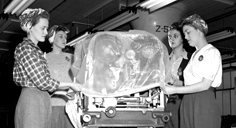Until World War II, the automotive industry was a mostly male bastion. But with so many men called to serve, more women than ever before sought employment. While their fathers, sons, husbands and friends fought in Europe and Asia, women served the war effort right at home, filling in quickly and capably.

Women Were Integral to the War Effort
In 1943, two years after the United States entered World War II, more than 30 percent of Ford workers in the machining and assembly departments were women. Women built jeeps, B-24 aircraft, and tractors. They even flew planes, becoming test pilots for the B-24s that were built for the war effort. They operated drill presses, welding tools, heavy casting machinery and—like Rose Will Monroe—riveting guns.
The Real Rosie the Riveter
Rose Will Monroe was working at Ford Motor Company's Willow Run plant when actor Walter Pidgeon chose her to appear in a promotional film for war bonds. That is how she became a real-life "Rosie the Riveter," as depicted in the colorful "We Can Do It!" posters showing a determined woman factory worker.
Rose Will Monroe had been left a widow with two young children after her husband was killed in a car accident. Like millions of other women in America, she joined the workforce to fulfill a call to arms and to support her family.
When the war ended, Rose Will Monroe and her female wartime colleagues were sent home so the returning soldiers could resume their prewar jobs. But the women had made their point, and had changed the American workplace forever.
A Lasting Contribution
After the war was over, gender was added to the nondiscrimination clause in the contract between the company and the UAW in 1946, another indication of the changing times and the impact that "Rosie the Riveter" had had on industrial production at Ford Motor Company and elsewhere. In the decades that followed, the laws caught up with the changes, and more women took their rightful places in the boardroom as well as on the factory floor.
